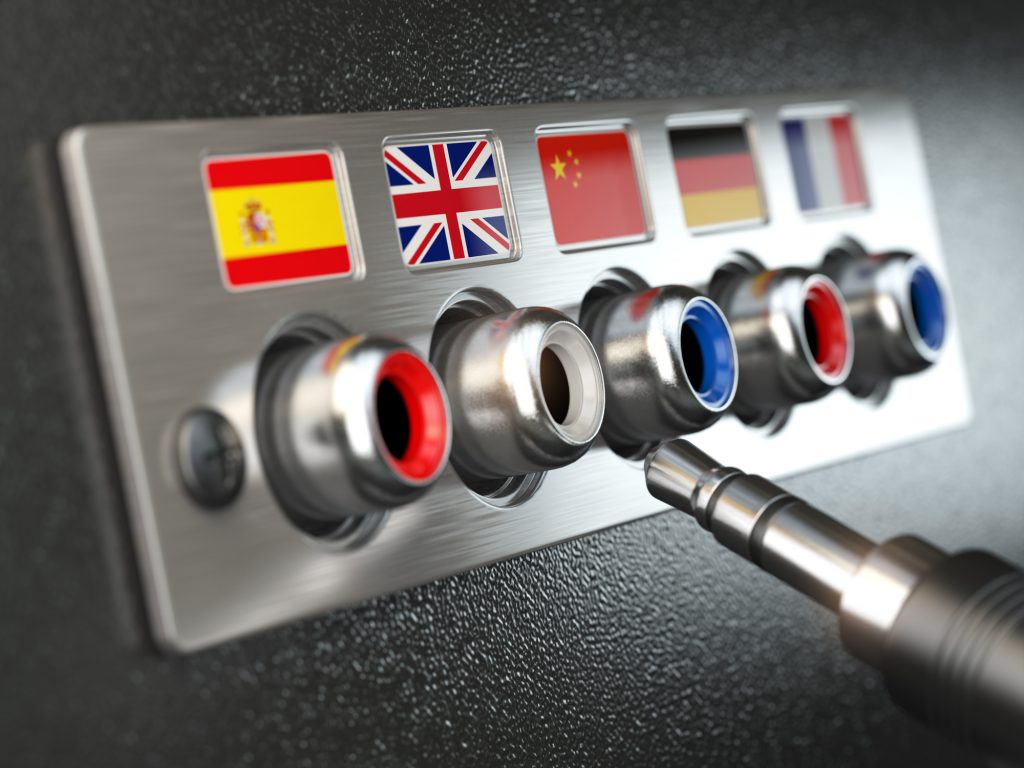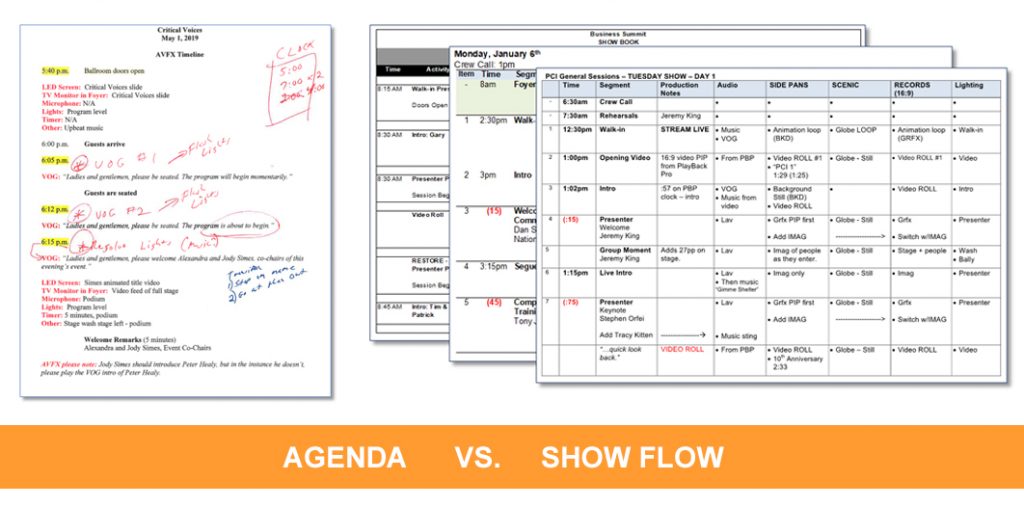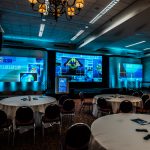18 AV terms every meeting planner should know
AV professionals speak the same language as the rest of us. Really.
They just change the meanings.
Mixers, rigging, throw distance—they are all English words, right?—but in AV world, they can have very different definitions than standard usage.

Here’s a handy guide from the professionals in the Rental and Staging Network to common AV terms. With this list, you’ll be speaking “AV” with confidence and next time you hear the tech team talking about a stage wash, you’ll know it has nothing to do cleaning the stage.
16:9: Is the most commonly used aspect ratio. Aspect ratios describe the proportional relationship between the vertical and horizontal dimensions of a screen, monitor or video. A 1:1 aspect ratio is a square because the dimensions are identical. A 16:9 aspect ratio on the other hand presents a panoramic image, measuring 16 units across and nine units high.
COC: If you are on the show communications (headsets), you might hear the crew say “COC,” which means “Client on Comms.”
Codec: When using video at an event, the technical crew will want to specify or know the format (.mp4, .mov) and codec for video files being used by presenters. The codec is the encoding/decoding tool used to convert raw data into a file and it determines the file size, which dictates the quality of the video.
Day Rate: The industry standard is 10 hours of labor. A half-day rate is five hours. Labor rates are typically calculated to the nearest half-day—so a 12-hour event will be charged for 1.5 days of labor (15 hours).
Green Room: A place backstage or otherwise away from audience view where presenters are often directed to wait before going up on stage.
The experts say: “The origin of the term ‘Green Room’ is uncertain. It is likely from either the Blackfriars Theatre in London from about 1599 or from a theatrical reference to the use of green felt in dressing/waiting rooms that was used to protect costumes from dirt and dust in the 17th century.”
– Steven Halling, president and CEO of EPN member AVFX
LED Screen: This doesn’t exist. A screen is where a projector throws images. An LED display is essentially a video monitor. Screens come in static shapes and sizes, while LED displays can be combined into any size or shape you can imagine. Read more about LED panels.
Load-In and Load-Out: Load-in is when the AV equipment is taken off the trucks and brought into the venue before the event. Also called set-up. After the event, the equipment is taken down and loaded out of the venue. Load-out is sometimes called strike. Whatever the pre- and post-event time is called, don’t forget to book enough time with the venue to avoid extra costs.
The experts say: “It’s critically important to block-off sufficient room time for staging and setup. Depending on the size of your event, a setup day (or two) may be necessary to accomplish load-in, layout, testing and rehearsal. Having adequate time for setup also helps avoid larger crew requirements and possibly overtime or even overnight fees.”
– Joe Kinney, creative design at EPN member, CMI AV.
Mic: Pronounced “Mike”, mic is the abbreviation for microphone. There are several kinds of common presenter mics, including DPA or headset mics, lav or lavalier mics (small, clip-on mics), handheld mics, podium mics and table mics.
The experts say: “A microphone is a microphone, right? In fact, there are hundreds of different types of mics that can make or break a presentation. For example, a headset mic is key for presenters that are soft spoken or presenting in a noisy environment.”
– Steven Halling, president and CEO of EPN member AVFX
Mixer: At an event, before the audio goes to the speakers, it passes through a mixer where it is processed. Also known as a soundboard, the mixer ensures that different sound sources—such as podium mics, musical instruments and videos–come together properly and sound right.
Overtime: Overtime is time-and-a-half. Calculate the overtime rate by dividing the day rate by 10 and multiplying the quotient by 1.5 (For example, overtime on a $500 day rate: (500/10)1.5 = $75. Double time is exactly what it sounds like—double the hourly wages will be charged.
Rigging: Any time you have equipment hanging over people’s heads at an event—such as speakers or lighting—you will require rigging. Venues are built with strong spots (rigging points) in their ceilings to hold this heavy equipment.
Show Flow: The show flow is a detailed document organized like a spreadsheet, with each department getting a column, including on-stage talent. The show flow includes everything the agenda has, but in far more detail. An agenda might list approximate times for each part of the event, such as Speaker A going on stage at 6:10 p.m., the show flow would break it down, noting the 46-second intro video, the lights that turn on for Speaker A when she walks on stage, which mic she will be using, if she’s using slides, and so on.
 Download your own show flow template, developed by EPN members, Steve Halling of AVFX and Eric Newkirk of CEAVCO, and keep your events running smoothly! Available here.
Download your own show flow template, developed by EPN members, Steve Halling of AVFX and Eric Newkirk of CEAVCO, and keep your events running smoothly! Available here.
Stage-Right: Stage direction is given as “up-stage,” “down-stage,” “stage-right” or “stage-left.” In relation to the audience, up-stage is further away, and down-stage is closer. Stage-right and left refer to the presenter’s right and left when facing the audience (the opposite of the audience’s right and left).
Stage Wash: Soft lighting on the stage. It brings focus to a certain area. Read more tips on stage lighting.
The experts say: “I like to put in a stage wash in all my shows. There’s a big difference when we don’t use a stage wash— without a stage wash, no one seems to focus on the speaker. Instead, the audience is talking and looking at different things. With the stage wash, their eyes automatically go to where you want them to go.”
– Jen Amburn, event producer at EPN member Colortone Staging & Rentals
Switcher: What a mixer does for audio, a switcher does for video. A switcher allows the AV team to feed two or more different sources into the same projector and switch from source to source, as well as keep a slide image on screen while switching sources.
Throw Distance: The throw is the distance between a projector lens and the screen. It is the distance that the projector throws the image. The throw distance determines what lens is needed for the image to properly fit the screen.
VOG: Voice of God. VOG is a generic term for an anonymous, disembodied voice that speaks to the audience. Examples include speaker introductions and audience directions (e.g. “Please take a moment to locate your nearest emergency exit.”).
WTFWYT: What the f*** were you thinking? Don’t do something to make your AV partner ask you this.
Now, you can “speak” AV and you’ll know what your AV team is saying when you hear terms like COC or VOG.
The Rental and Staging Network is comprised of 25 of the AV industry’s premier live event staging companies. EPN members are consistently chosen by event planners and producers when they need events that wow. Representing 29 major markets across North America, EPN has you covered, no matter where you are. Find your local AV partner here.


